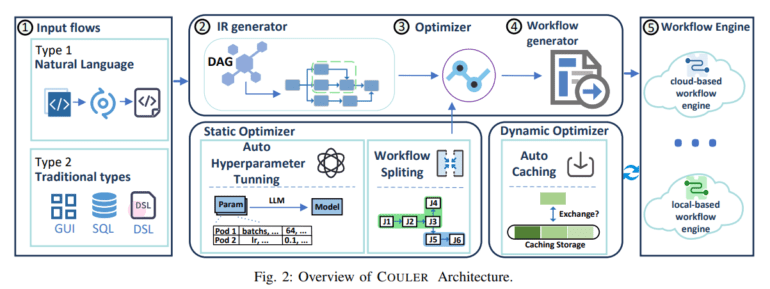- COULER revolutionizes ML workflow management by leveraging natural language descriptions and Large Language Models (LLMs) to automate workflow generation.
- It simplifies interactions with diverse workflow engines, reducing the complexity of mastering multiple engine APIs.
- COULER introduces automated caching, auto-parallelization, and hyperparameter tuning to enhance workflow efficiency.
- Deployed in Ant Group’s production environment, COULER demonstrates significant improvements in CPU/Memory utilization and workflow completion rates.
Main AI News:
In the ever-evolving landscape of machine learning (ML), the complexities and scale of workflows have posed challenges to conventional optimization methods. With these workflows serving as the backbone of data-driven innovations across various sectors, organizations face escalating operational costs and resource demands. Navigating through disparate workflow engines with unique Application Programming Interfaces (APIs) further complicates the optimization process, especially in multi-platform environments. The need for a unified and efficient approach to ML workflow management has never been more pressing.
Enter COULER, a groundbreaking solution developed by a collaborative effort from Ant Group, Red Hat, Snap Inc., and Sichuan University. This innovative system redefines ML workflow management by harnessing natural language (NL) descriptions to automate workflow generation. Integrated with Large Language Models (LLMs), COULER simplifies interactions with diverse workflow engines, streamlining the creation and supervision of intricate ML operations. This approach not only reduces the complexity of mastering multiple engine APIs but also paves the way for unparalleled optimization in cloud environments.
At its core, COULER introduces three pivotal enhancements to traditional ML workflows:
- Automated caching: By strategically implementing caching mechanisms at various stages, COULER minimizes redundant computational expenses, thereby enhancing overall workflow efficiency.
- Auto-parallelization: This feature empowers the system to optimize the execution of extensive workflows, significantly boosting computational performance.
- Hyperparameter tuning: COULER automates the critical task of hyperparameter tuning, ensuring optimal model performance while minimizing human intervention.
Together, these innovations drive substantial improvements in workflow execution. Deployed within Ant Group’s production environment, COULER manages approximately 22,000 workflows daily, showcasing its resilience and efficacy. Noteworthy achievements include a remarkable 15% enhancement in CPU/Memory utilization and a 17% increase in workflow completion rates. These results underscore COULER’s transformative potential in revolutionizing ML workflow optimization, providing organizations with a seamless and cost-effective solution for their data-driven initiatives.
Conclusion:
The introduction of COULER signifies a major advancement in the ML workflow optimization landscape. Its ability to automate complex tasks and streamline interactions across various platforms promises to drive efficiency and cost-effectiveness for organizations. COULER’s success in Ant Group’s environment highlights its potential to transform the market by providing a seamless solution for data-driven initiatives. Businesses should take note of COULER’s capabilities to stay ahead in the competitive landscape of machine learning.

